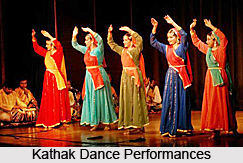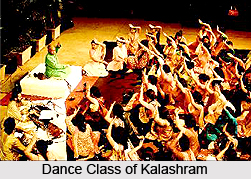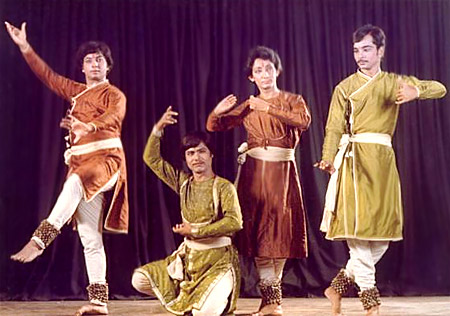 Kalashram in New Delhi is the dream institution of the Kathak maestro Pandit Birju Maharaj. The institute focuses on imparting training mainly in the field of Kathak, along with various other related disciplines like vocal and instrumental music, painting, yoga, Sanskrit, stagecraft, dramatics and so on. Kalashram is sited in a natural environment, with minimum material structures.
Kalashram in New Delhi is the dream institution of the Kathak maestro Pandit Birju Maharaj. The institute focuses on imparting training mainly in the field of Kathak, along with various other related disciplines like vocal and instrumental music, painting, yoga, Sanskrit, stagecraft, dramatics and so on. Kalashram is sited in a natural environment, with minimum material structures.
The classrooms, meditation rooms, practice halls and amphitheatre of the Kalashram reflect a rural setup in an urban area. The natural atmosphere, with numerous trees, pond and serene surrounding, Kalashram is an extremely inspiring school for performing arts that attracts hundreds of aspiring dancers from all parts of India and abroad. The dancers dwell in simple, unassuming, but rich heritage of Kathak dance. The institute is run on entirely charitable basis with no tuition fees from the students. The objective of the Kalashram is primarily to produce highly talented students who would not only prove worthy of the training that they receive, but also live a modest, humble and disciplined life in today`s society.
Kalashram aims to become a symbol of such that `Kala` is worshipped through the effort and honesty of the students and teachers. Duty, dedication and devotion then become the necessities of Dharma in the Kalashram. This socio-religious outlook lifts performing art to the level of a prayer and each student performs with utmost dedication not for himself but for society at large. The individual interests are then superimposed by a naive approach, where art is taught and learnt for the advantage of the masses and an understanding develops between art, the artiste and the primeval teacher `Prakriti`.
 Kalashram follows the Guru-Shishya Parampara that leads to a direct interaction of the teacher and the student, making the relation special and personal as well. The main concern of the teachers is to give individual attention to the students, thus helping them to grow and mature into complete artistes. Though dance is the main subject for specialisation, other closely related arts are also important elements of the curriculum like vocal, percussion, instrumental, yoga, voice culture, and Sanskrit. The students of Kalashram experiences the exposure through workshops, lecture demonstrations in all kinds of art forms like painting, sculpture, crafts and dramatics, and a general awareness is aimed to be created towards the rich legacy of Indian literature, where old classics and. modern literature is dealt with together. Thus, the students of Kalashram grow up to be the responsible citizens of India.
Kalashram follows the Guru-Shishya Parampara that leads to a direct interaction of the teacher and the student, making the relation special and personal as well. The main concern of the teachers is to give individual attention to the students, thus helping them to grow and mature into complete artistes. Though dance is the main subject for specialisation, other closely related arts are also important elements of the curriculum like vocal, percussion, instrumental, yoga, voice culture, and Sanskrit. The students of Kalashram experiences the exposure through workshops, lecture demonstrations in all kinds of art forms like painting, sculpture, crafts and dramatics, and a general awareness is aimed to be created towards the rich legacy of Indian literature, where old classics and. modern literature is dealt with together. Thus, the students of Kalashram grow up to be the responsible citizens of India.
 The purpose of Kalashram is constant search for perfection, to create high quality performance artistes, committed research scholars and skilled teachers. The criterion for admission is strictly genuine depending on the merit dedication and deep interest in the art and thus the principles of Kalashram strives towards a qualitative growth of the students rather than a quantitative increase in the number of admissions. Since no tuition fee is charged, admission in Kalashram is open to all sections of the society. Special encouragement is given to the students from under privileged classes, but the actual focal point lies in the intensity of potential and promise.
The purpose of Kalashram is constant search for perfection, to create high quality performance artistes, committed research scholars and skilled teachers. The criterion for admission is strictly genuine depending on the merit dedication and deep interest in the art and thus the principles of Kalashram strives towards a qualitative growth of the students rather than a quantitative increase in the number of admissions. Since no tuition fee is charged, admission in Kalashram is open to all sections of the society. Special encouragement is given to the students from under privileged classes, but the actual focal point lies in the intensity of potential and promise.
The faculty of Kalashram feels their responsibility to guide their students towards the right path and inculcate in them some moral values of life. Special care is taken to help the young students to develop a proper attitude and approach towards performing arts and a final commitment to society, thereby developing a good artistic taste and harmony in life through music.
The activities in Kalashram are primarily regular classes and training in Kathak, instrumental music, vocal music, painting and the fine arts. Also, weekly classes in Sanskrit yoga, ancient and modem literature and dance theory. Sometimes, periodic lectures and demonstrations are also given in dramatics, stagecraft, presentation, and Natyashastra. Lectures on nature and environment; the Vedas and the Puranas; Indian heritage; other dance forms and genres and choreography form a section of the curriculum. Several seminars and discourses on various other arts related issues, monthly baithaks with intimate performance sessions, audio and visual reproductions; recording, archiving, and discussions are also a part of activities in Kalashram.With its uniqueness Kalashram remains as one of the promising institutes of Kathak.



















